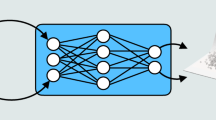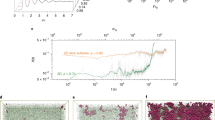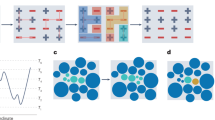Abstract
Despite decades of theoretical studies, the nature of the glass transition remains elusive and debated, while the existence of structural predictors of its dynamics is a major open question. Recent approaches propose inferring predictors from a variety of human-defined features using machine learning. Here we determine the long-time evolution of a glassy system solely from the initial particle positions and without any handcrafted features, using graph neural networks as a powerful model. We show that this method outperforms current state-of-the-art methods, generalizing over a wide range of temperatures, pressures and densities. In shear experiments, it predicts the locations of rearranging particles. The structural predictors learned by our network exhibit a correlation length that increases with larger timescales to reach the size of our system. Beyond glasses, our method could apply to many other physical systems that map to a graph of local interaction.
This is a preview of subscription content, access via your institution
Access options
Access Nature and 54 other Nature Portfolio journals
Get Nature+, our best-value online-access subscription
$29.99 / 30 days
cancel any time
Subscribe to this journal
Receive 12 print issues and online access
$209.00 per year
only $17.42 per issue
Buy this article
- Purchase on Springer Link
- Instant access to full article PDF
Prices may be subject to local taxes which are calculated during checkout





Similar content being viewed by others
Data availability
The data represented in Figs. 1, 3a–d, 4a and 5, and Extended Data Figs. 1, 3 and 7 are available as Source Data. Training data at all four temperatures studied in the text are available at https://github.com/deepmind/deepmind-research/tree/master/glassy_dynamics. All other data that support the plots within this paper and other findings of this study are available from the corresponding author upon reasonable request.
Code availability
Source code for training and evaluating our graph network is available at https://github.com/deepmind/deepmind-research/tree/master/glassy_dynamics.
Change history
16 April 2020
A Correction to this paper has been published: https://doi.org/10.1038/s41567-020-0901-1
References
Angell, C. A. Formation of glasses from liquids and biopolymers. Science 267, 1924–1935 (1995).
Sastry, S., Debenedetti, P. G. & Stillinger, F. H. Signatures of distinct dynamical regimes in the energy landscape of a glass-forming liquid. Nature 393, 554–557 (1998).
Debenedetti, P. G. & Stillinger, F. H. Supercooled liquids and the glass transition. Nature 410, 259–267 (2001).
Biroli, G. & Garrahan, J. P. Perspective: the glass transition. J. Chem. Phys. 138, 12A301 (2013).
Chandler, D. & Garrahan, J. P. Dynamics on the way to forming glass: bubbles in space-time. Annu. Rev. Phys. Chem. 61, 191–217 (2010).
Keys, A. S., Hedges, L. O., Garrahan, J. P., Glotzer, S. C. & Chandler, D. Excitations are localized and relaxation is hierarchical in glass-forming liquids. Phys. Rev. X 1, 021013 (2011).
Cammarota, C. & Biroli, G. Ideal glass transitions by random pinning. Proc. Natl Acad. Sci. USA 109, 8850–8855 (2012).
Berthier, L. et al. Growing timescales and lengthscales characterizing vibrations of amorphous solids. Proc. Natl Acad. Sci. USA 113, 8397–8401 (2016).
Schwartzman-Nowik, Z., Lerner, E. & Bouchbinder, E. Anisotropic structural predictor in glassy materials. Phys. Rev. E 99, 060601 (2019).
Biroli, G. & Landes, F. Solve a major physics problem by finding how to predict the dynamics of glass-forming liquids. https://challengedata2.ens.fr/en/challenge/46/solve_a_major_physics_problem_by_finding_how_to_predict_the_dynamics_of_glass-forming_liquids.html (2018).
Cubuk, E. D. et al. Identifying structural flow defects in disordered solids using machine-learning methods. Phys. Rev. Lett. 114, 108001 (2015).
Schoenholz, S. S., Cubuk, E. D., Sussman, D. M., Kaxiras, E. & Liu, A. J. A structural approach to relaxation in glassy liquids. Nat. Phys. 12, 469 EP (2016).
Harrington, M., J.Liu, A. & J.Durian, D. Machine learning characterization of structural defects in amorphous packings of dimers and ellipses. Phys. Rev. E 99, 022903 (2019).
Sharp, T. A. et al. Machine learning determination of atomic dynamics at grain boundaries. Proc. Natl Acad. Sci. USA 115, 10943–10947 (2018).
Sussman, D. M., Schoenholz, S. S., Cubuk, E. D. & Liu, A. J. Disconnecting structure and dynamics in glassy thin films. Proc. Natl Acad. Sci. USA 114, 10601–10605 (2017).
Cortes, C. & Vapnik, V. Support-vector networks. Mach. Learn. 20, 273–297 (1995).
Scarselli, F., Gori, M., Tsoi, A., Hagenbuchner, M. & Monfardini, G. The graph neural network model. IEEE Trans. Neural Netw. 20, 61–80 (2009).
Battaglia, P., Pascanu, R., Lai, M., Rezende, D. & Kavukcuoglu, K. Interaction networks for learning about objects, relations and physics. Adv. Neural Inf. Process. Syst. 29, 4502–4510 (2016).
Battaglia, P. W. et al. Relational inductive biases, deep learning, and graph networks. Preprint at https://arxiv.org/abs/1806.01261 (2018).
Santoro, A. et al. A simple neural network module for relational reasoning. Adv. Neural Inf. Process. Syst. 30, 4967–4976 (2017).
Chang, M. B., Ullman, T., Torralba, A. & Tenenbaum, J. B. A compositional object-based approach to learning physical dynamics. In Proc. International Conference on Learning Representations (ICLR) (2017); https://openreview.net/forum?id=Bkab5dqxe
Sanchez-Gonzalez, A. et al. Graph networks as learnable physics engines for inference and control. In Proc. 35th International Conference on Machine Learning (ICML) 4470–4479 (2018).
Li, Y., Wu, J., Tedrake, R., Tenenbaum, J. B. & Torralba, A. Learning particle dynamics for manipulating rigid bodies, deformable objects, and fluids. In Proc. International Conference on Learning Representations (ICLR) (2019); https://iclr.cc/Conferences/2019/Schedule?showEvent=852
Bello, I., Pham, H., Le, Q. V., Norouzi, M. & Bengio, S. Neural combinatorial optimization with reinforcement learning. Preprint at https://arxiv.org/abs/1611.09940 (2016).
Nowak, A., Villar, S., Bandeira, A. S. & Bruna, J. A note on learning algorithms for quadratic assignment with graph neural networks. In Proc. Principled Approaches to Deep Learning Workshop (PADL) at the International Conference of Machine Learning (ICML) (2017); https://www.padl.ws/papers/Paper%2017.pdf
Dai, H., Khalil, E.B., Zhang, Y., Dilkina, B. & Song, L. Learning combinatorial optimization algorithms over graphs. Adv. Neural Inf. Process. Syst. 30, 6348–6358 (2017).
Selsam, D. et al. Learning a SAT solver from single-bit supervision. In Proc. International Conference on Learning Representations (ICLR) (2019); https://iclr.cc/Conferences/2019/Schedule?showEvent=726
Mari, R., Krzakala, F. & Kurchan, J. Jamming versus glass transitions. Phys. Rev. Lett. 103, 025701 (2009).
Donati, C., Glotzer, S. C., Poole, P. H., Kob, W. & Plimpton, S. J. Spatial correlations of mobility and immobility in a glass-forming lennard-jones liquid. Phys. Rev. E 60, 3107–3119 (1999).
Berthier, L. & Jack, R. L. Structure and dynamics of glass formers: predictability at large length scales. Phys. Rev. E 76, 041509 (2007).
Widmer-Cooper, A. & Harrowell, P. On the study of collective dynamics in supercooled liquids through the statistics of the isoconfigurational ensemble. J. Chem. Phys. 126, 154503 (2007).
Doliwa, B. & Heuer, A. What does the potential energy landscape tell us about the dynamics of supercooled liquids and glasses? Phys. Rev. Lett. 91, 235501 (2003).
Widmer-Cooper, A. & Harrowell, P. Predicting the long-time dynamic heterogeneity in a supercooled liquid on the basis of short-time heterogeneities. Phys. Rev. Lett. 96, 185701 (2006).
Widmer-Cooper, A. & Harrowell, P. Free volume cannot explain the spatial heterogeneity of Debye–Waller factors in a glass-forming binary alloy. J. Non-Cryst. Solids 352, 5098–5102 (2006).
Widmer-Cooper, A., Perry, H., Harrowell, P. & Reichman, D. R. Irreversible reorganization in a supercooled liquid originates from localized soft modes. Nat. Phys. 4, 711–715 (2008).
Keys, A. S., Abate, A. R., Glotzer, S. C. & Durian, D. J. Measurement of growing dynamical length scales and prediction of the jamming transition in a granular material. Nat. Phys. 3, 260–264 (2007).
Rodney, D., Tanguy, A. & Vandembroucq, D. Modeling the mechanics of amorphous solids at different length scale and time scale. Model. Simul. Mater. Sci. Eng. 19, 083001 (2011).
Barbot, A. et al. Local yield stress statistics in model amorphous solids. Phys. Rev. E 97, 033001 (2018).
Cubuk, E. D., Schoenholz, S. S., Kaxiras, E. & Liu, A. J. Structural properties of defects in glassy liquids. J. Phys. Chem. B 120, 6139–6146 (2016).
Maloney, C. E. & Lemaître, A. Amorphous systems in athermal, quasistatic shear. Phys. Rev. E 74, 016118 (2006).
Schoenholz, S. S., Liu, A. J., Riggleman, R. A. & Rottler, J. Understanding plastic deformation in thermal glasses from single-soft-spot dynamics. Phys. Rev. X 4, 031014 (2014).
Candelier, R. et al. Spatiotemporal hierarchy of relaxation events, dynamical heterogeneities, and structural reorganization in a supercooled liquid. Phys. Rev. Lett. 105, 135702 (2010).
Kob, W., Roldan-Vargas, S. & Berthier, L. Non-monotonic temperature evolution of dynamic correlations in glass-forming liquids. Nat. Phys. 8, 164–167 (2012).
Cubuk, E. D. et al. Structure-property relationships from universal signatures of plasticity in disordered solids. Science 358, 1033–1037 (2017).
Berthier, L., Coslovich, D., Ninarello, A. & Ozawa, M. Equilibrium sampling of hard spheres up to the jamming density and beyond. Phys. Rev. Lett. 116, 238002 (2016).
He, S. et al. Learning to predict the cosmological structure formation. Proc. Natl Acad. Sci. USA 116, 13825–13832 (2019).
Angell, C. A., Ngai, K. L., McKenna, G. B., McMillan, P. F. & Martin, S. W. Relaxation in glassforming liquids and amorphous solids. J. Appl. Phys. 88, 3113–3157 (2000).
van der Maaten, L. & Hinton, G. Visualizing data using t-SNE. J. Mach. Learn. Res. 9, 2579–2605 (2008).
Plimpton, S. Fast parallel algorithms for short-range molecular dynamics. J. Comput. Phys. 117, 1–19 (1995).
Kob, W. & Andersen, H. C. Testing mode-coupling theory for a supercooled binary Lennard–Jones mixture I: the van Hove correlation function. Phys. Rev. E 51, 4626 (1995).
Falk, M. L. & Langer, J. S. Dynamics of viscoplastic deformation in amorphous solids. Phys. Rev. E 57, 7192–7205 (1998).
Buchlovsky, P. et al. TF-replicator: distributed machine learning for researchers. Preprint at https://arxiv.org/abs/1902.00465 (2019).
Pedregosa, F. et al. Scikit-learn: machine learning in python. J. Mach. Learn. Res. 12, 2825–2830 (2011).
Acknowledgements
We thank F. Zamponi for critical input on this work, and our colleagues A. Ballard, P. Battaglia, J. Jumper, J. Kirkpatrick, N. Rabinowitz, A. Sanchez-Gonzalez, A. Senior and P. Wirnsberger for many useful discussions.
Author information
Authors and Affiliations
Contributions
V.B. conceived and led the overall study. V.B., T.K., A.G.-B. and C.D. created the data, trained the machine learning models and analysed the results. V.B., T.K., A.G.-B. and C.D. wrote the paper with contributions from E.D.C., S.S.S., T.B. and P.K. and comments from all other authors. E.D.C. and S.S.S. provided advice on the physics of the system. A.O., A.W.R.N., T.B., D.H. and P.K. managed and coordinated the overall project.
Corresponding author
Ethics declarations
Competing interests
The authors declare no competing interests.
Additional information
Peer review information Nature Physics thanks Giulio Biroli and Vincenzo Vitelli for their contribution to the peer review of this work.
Publisher’s note Springer Nature remains neutral with regard to jurisdictional claims in published maps and institutional affiliations.
Extended data
Extended Data Fig. 1 Ablation of the dataset size.
Pearson correlation coefficient (left) and accuracy metric (right) for the graph neural network trained on different number of training examples. Each training example is augmented by applying the 24 symmetries of the box.
Extended Data Fig. 2 Effects of the edge thresholds and number of recurrences on the graph network’s performance.
Pearson correlation coefficient for the ‘none’ network (no features, top) and the default network (distance and type features, bottom) for the ballistic, glassy and diffusive timescales (from left to right). Each point shows the median value of 3-10 independently trained networks. While in the first case there are some sharp peaks upon varying the edge threshold, in the second case the prediction monotonously increases with the edge threshold. Note that the prediction’s quality always increases with the number of recurrences.
Extended Data Fig. 3 Correlation coefficients for all temperatures and timescales.
Pearson correlation coefficients for the machine learning methods and physics baselines, for the 4 different temperatures considered for training. The glassy timescale is indicated by a dashed line on each plot. Each point and its error bars shows the median, best and worst of ten independently-trained models.
Extended Data Fig. 4 GNN samples.
Qualitative results for the first 10 test-data configurations (columns) at the 10 investigated times-scales (rows) for T = 0.44. Linear interpolation of the propensity predicted by the GNN and the 10 % most mobile particles (black) in a two-dimensional slice through the simulation box.
Extended Data Fig. 5 Soft modes samples.
Qualitative results for the first 10 test-data configurations (columns) at the 10 investigated times-scales (rows) for T = 0.44. Linear interpolation of the propensity predicted by the SM baseline and the 10 % most mobile particles (black) in a two-dimensional slice through the simulation box.
Extended Data Fig. 6 Ground truth samples.
Qualitative results for the first 10 test-data configurations (columns) at the 10 investigated times-scales (rows) for T = 0.44. Linear interpolation of the ground truth and the 10 % most mobile particles (black) in a two-dimensional slice through the simulation box.
Extended Data Fig. 7 Propensity distributions.
Propensity distribution of type A particles for different state points at \(\tau_{\textrm{g}}\): a) the mean expected displacement and b) the predicted displacements. With decreasing temperature, the tails of the distributions become more pronounced.
Extended Data Fig. 8 Shell ablation experiment.
Shell ablation experiments for different temperatures. Ten models are shown per condition, their median is represented with the thick dashed line. For the ballistic regime, two shells are enough for the correct prediction. Only in the coolest regime (T=0.44), an extra shell improves the result. As the temperature cools, the number of shells required for the correct prediction grows from about three for T=0.56 to five at T=0.44. The diffusive regime seems to require fewer shells.
Extended Data Fig. 9 Shell perturbation experiment.
Edge perturbation experiments for all temperatures examined, as in Fig. 5c, ten models shown per condition. Note that the number of edges goes down at higher temperatures due to the changing box size.
Extended Data Fig. 10 Linear propensity prediction.
Linear regression on the number of neighbouring particles within a sphere of a given size (x-axis). Results are shown for different S(q,t) values, and different temperatures (colour). Linear prediction gets easier with time and lower temperature. Nearest neighbours matter most for the ballistic regime, whereas for glassy and diffusive regime, best discrimination is achieved for larger spheres. There, wavy pattern shifts with temperature. The shift gets removed by re-scaling the x-axis to match the box size of all four conditions.
Supplementary information
Supplementary Information
Supplementary figures and text.
Source data
Source Data Fig. 1
Figure curves source.
Source Data Fig. 3
Figure curves source.
Source Data Fig. 4
Figure curves source.
Source Data Fig. 5
Figure curves source.
Source Data Extended Data Fig. 1
Figure curves source.
Source Data Extended Data Fig. 3
Figure curves source.
Source Data Extended Data Fig. 7
Figure curves source.
Rights and permissions
About this article
Cite this article
Bapst, V., Keck, T., Grabska-Barwińska, A. et al. Unveiling the predictive power of static structure in glassy systems. Nat. Phys. 16, 448–454 (2020). https://doi.org/10.1038/s41567-020-0842-8
Received:
Accepted:
Published:
Issue Date:
DOI: https://doi.org/10.1038/s41567-020-0842-8
This article is cited by
-
Zero-shot learning of aerosol optical properties with graph neural networks
Scientific Reports (2023)
-
Machine learning dislocation density correlations and solute effects in Mg-based alloys
Scientific Reports (2023)
-
Modern computational studies of the glass transition
Nature Reviews Physics (2023)
-
Finding defects in glasses through machine learning
Nature Communications (2023)
-
Topology of vibrational modes predicts plastic events in glasses
Nature Communications (2023)



